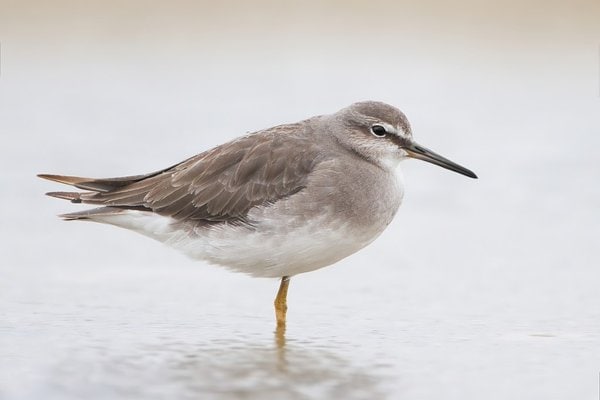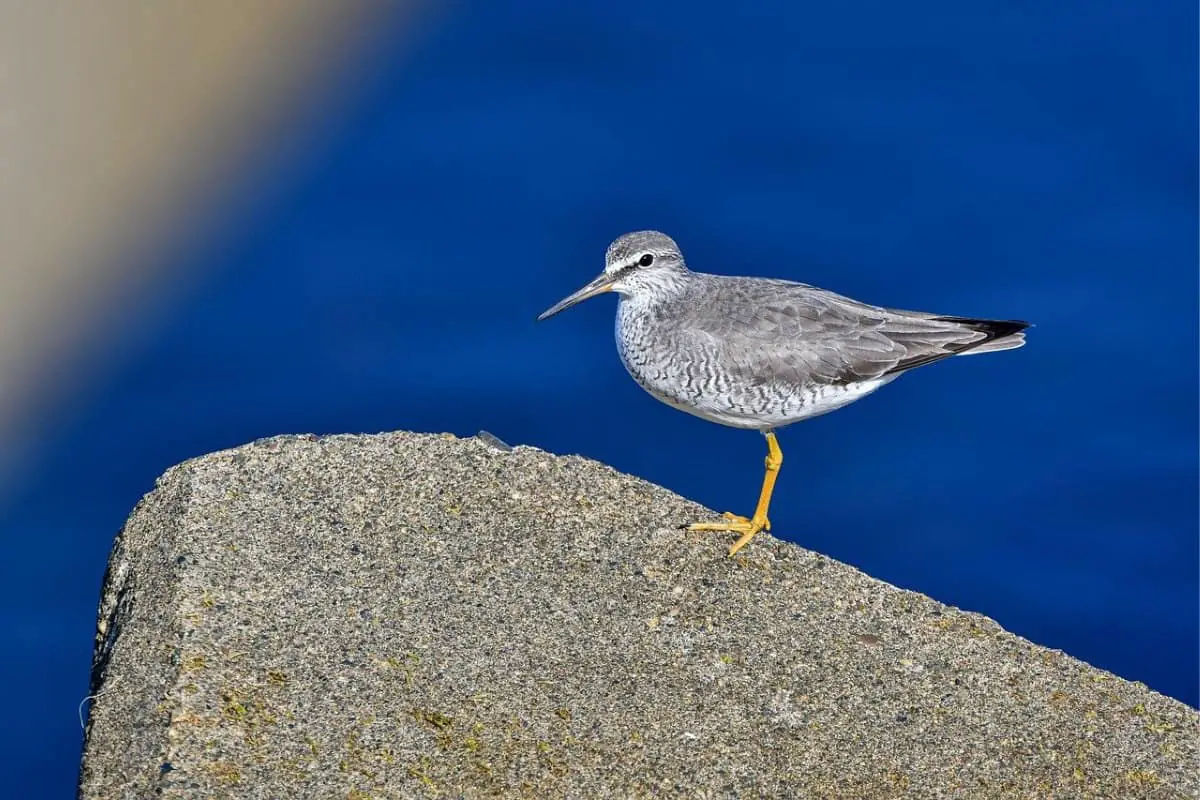Common Name: Gray-tailed Tattler
Scientific Name: (Tringa brevipes)| Size | Diet | Range in Hawaii | Status in Hawaii |
|---|---|---|---|
| 8 in. - 9 in. | crustaceans and mollusks | Oahu, Maui, Kauai, and Hawaii (Big Island) | Near Threatened |
The Gray-tailed Tattler, also known as Tringa brevipes, is a small shorebird species that is native to the coastal regions of East Asia and Australia. While the species is not native to Hawaii, it has been known to occasionally visit the islands as a non-breeding visitor and occasional vagrant. With its unique appearance and distinctive behavior, the Gray-tailed Tattler is a fascinating bird species that has captured the attention of birdwatchers and avian enthusiasts around the world.
In this article, we will explore the world of the Gray-tailed Tattler, its unique characteristics, and its occasional presence in Hawaii.
Gray-tailed Tattler
Appearance

The gray-tailed tattler is a captivating shorebird with striking features. Standing at approximately 8 to 9 inches in length, it boasts a petite yet elegant stature. What sets this bird apart is its distinctive grayish-blue plumage, adorned with intricate patterns of streaks and spots.
Its namesake, the gray tail, is a subtle but eye-catching detail, contrasting beautifully with its white underparts. This avian wanderer is a testament to the beauty found in nature’s subtle and delicate artistry.
Diet
The gray-tailed tattler is a gourmet of the shoreline, known for its eclectic and fascinating diet. With a keen eye for delicacies hidden beneath the sand and mud, it primarily feasts on a smorgasbord of invertebrates. From tiny crustaceans like amphipods and crabs to delectable worms and mollusks, this bird is a true connoisseur of the intertidal buffet.
Nesting
The nesting habits of the gray-tailed tattler are a testament to its secretive and adventurous nature. Nesting in the remote and rugged terrain of the Arctic tundra, these birds choose well-concealed spots among the mossy, lichen-covered rocks. Their nests are shallow scrapes in the ground, expertly lined with plant material and softened with down feathers from their own plumage.
What makes their nesting even more intriguing is the timing. Gray-tailed tattlers undertake long migrations from their wintering grounds in the Southern Hemisphere to the Arctic during the brief Arctic summer.
Here, under the midnight sun, they lay their eggs in late June or early July. These resilient birds nest amidst an environment that undergoes rapid changes, from snow and ice to vibrant greenery in a matter of weeks.
Behavior

The gray-tailed tattler is a master of coastal choreography, its behavior a captivating dance along the water’s edge. These elegant shorebirds are often seen wading through shallow waters with graceful strides, their long, slender bills expertly probing the sand and mud for hidden treasures.
They are social beings, often found in small groups or mixed flocks with other shorebirds, creating a symphony of calls and movements. During their migration, they embark on long journeys, covering thousands of miles between their breeding and wintering grounds with unwavering determination.
One of their most intriguing habits is their nomadic lifestyle. They have no fixed abode, traveling to various locations across Asia, Australia, and the Pacific, depending on the season. This wanderlust showcases their adaptability and resilience.
Perhaps most fascinating is their courtship display, where males engage in acrobatic flights and melodious calls to woo potential mates, a spectacle that adds an element of romance to their coastal wanderings.
Habitat

During the breeding season, they seek out the remote and expansive Arctic tundra in places like Siberia. Here, amidst the stark beauty of the northern landscape, they create nests in hidden depressions, perfectly camouflaged among rocks and sparse vegetation.
During migration, they make stopovers in estuaries, mudflats, and coastal wetlands, often congregating with other shorebirds. When winter descends, the gray-tailed tattlers embark on long journeys to warmer locales such as Southeast Asia, Australia, and the Pacific Islands. Here, they find refuge in tropical and subtropical coastal areas, bays, and intertidal zones, where they continue their quest for sustenance.
Range
The Gray-tailed tattlers occasionally visit different parts of the Hawaiian archipelago during migration, making their presence infrequent and somewhat unpredictable. They have been spotted in various locations across the Hawaiian Islands. These sightings have occurred on several islands, including Oahu, Maui, Kauai, and Hawaii (Big Island).
Conservation Status
The conservation status of the gray-tailed tattler is a matter of concern, as this charming shorebird faces various threats along its migratory routes and breeding grounds. According to the International Union for Conservation of Nature (IUCN), the gray-tailed tattler is classified as “Near Threatened.”
Interesting Facts
1. Sexual dimorphism
Gray-tailed tattlers exhibit sexual dimorphism, with males and females having slightly different plumage. Males often have darker and more heavily streaked plumage than females.
2. Oxygen adaptation
At their breeding grounds in the Arctic, where oxygen levels are lower due to the high latitude, gray-tailed tattlers have developed adaptations that allow them to efficiently extract oxygen from the thin air.
3. Cultural significance
In some regions, gray-tailed tattlers hold cultural significance. For example, in Australia, they are known as “Wandering Tattlers” and are considered important in Indigenous culture.
4. Monogamous breeding pairs
During the breeding season, gray-tailed tattlers typically form monogamous pairs. These pairs work together to incubate the eggs and care for the chicks.
5. Citizen science
Birdwatchers and ornithologists often contribute valuable data to the study of gray-tailed tattlers and other migratory shorebirds. Citizen science projects help track their movements and contribute to their conservation.
Frequently Asked Questions
1. Why are gray-tailed tattlers considered “Near Threatened”?
Their conservation status is “Near Threatened” due to habitat loss and degradation along their migratory routes and breeding areas, as well as the impact of climate change.
2. How long do gray-tailed tattlers live?
The lifespan of gray-tailed tattlers can vary, but they are generally considered to have a relatively long lifespan for a small shorebird, possibly living up to 10-15 years.
3. Can gray-tailed tattlers be kept as pets?
No, it is illegal and harmful to keep wild birds like gray-tailed tattlers as pets. They are protected by conservation laws in many countries.
4. Are gray-tailed tattlers considered a flagship species for conservation?
Yes, they are often used as flagship species for the conservation of coastal and estuarine habitats because protecting their habitats benefits numerous other species that rely on these ecosystems.
5. How can I help conserve gray-tailed tattlers?
You can support conservation efforts by participating in citizen science projects, supporting organizations focused on bird conservation, and advocating for the protection of crucial stopover sites along their migratory routes.




